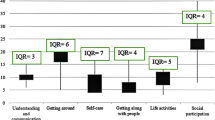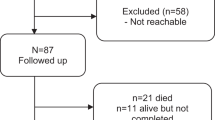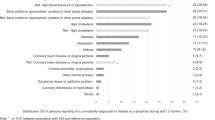Abstract
Study design
Cross-sectional study.
Objectives
To determine the Quality of Life (QOL) in individuals with traumatic Spinal Cord Injury (SCI) of thoracolumbar region in Indian population, the factors affecting QOL and to compare this to other SCI populations.
Setting
Tertiary level hospital in low-middle income country.
Methods
93 individuals with SCI of minimum 1 year duration since injury were included in the study. Baseline demographics, socioeconomic parameters, and incidence of complications were ascertained. World Health Organisation Quality of Life-BREF (WHOQOL-BREF) score was used for measurement of QOL and was then compared to healthy Indian population and other SCI studies. Subgroup analysis was done to find out impact of variables on different domains of WHOQOL-BREF.
Results
The median (IQR) age of the study participants was 35 (25, 45) with a male predominance. The median (IQR) duration since injury in the study population was 50 (26, 70) months. Lowest mean (SD) score was observed in the psychological domain −50.3 (12.1) and comparison to healthy Indian and high-income SCI populations revealed drastically decreased scores across all domains (p < 0.01). Employed individuals and housewives had significantly higher scores across all domains than unemployed individuals (p < 0.05). American Spinal Injury Association Impairment Scale (AIS) grade, socioeconomic status, pain and presence of complications all had significant impact on domain scores (p < 0.05). Multiple regression analysis revealed that mobilisation status and pain had the greatest effect on QOL.
Conclusion
Individuals with SCI have low QOL scores as compared to general Indian population as well as SCI individuals from a high resource setting. Pain and dependent mobilisation were found to be most significant predictors of poor WHOQOL-BREF domain scores. Housewives were found to have domain scores comparable to employed individuals. Presence of complications negatively impacts QOL.
This is a preview of subscription content, access via your institution
Access options
Subscribe to this journal
Receive 12 print issues and online access
$259.00 per year
only $21.58 per issue
Buy this article
- Purchase on Springer Link
- Instant access to full article PDF
Prices may be subject to local taxes which are calculated during checkout


Similar content being viewed by others
Data availability
The authors declare that the data is transparent. The original data has been entered in Microsoft Excel and can be made available in case the journal wishes.
References
deRoon-Cassini T, de St. Aubin E, Valvano A, Hastings J, Horn P. Psychological well-being after spinal cord injury: perception of loss and meaning making. Rehabil Psychol. 2009;54:306–14.
Wilson JR, Hashimoto RE, Dettori JR, Fehlings MG. Spinal cord injury and quality of life: a systematic review of outcome measures. Evid Based Spine Care. 2011;2:37–44.
Singh R, Dhankar SS, Rohilla R. Quality of life of people with spinal cord injury in Northern India. Int J Rehabil Res. 2008;31:247–51.
Kumar N, Gupta B. Effect of spinal cord injury on quality of life of affected soldiers in india: a cross sectional study. Asian Spine J. 2016;10:267–75.
McColl MA, Charlifue S, Glass C, Savic G, Meehan M. International differences in ageing and spinal cord injury. Spinal Cord. 2002;40:128–36.
Sharma R. Revised Kuppuswamy’s socioeconomic status scale: explained and updated. Indian Pediatr. 2017;54:867–70.
Roberts T, Leonard G, Cepela D. Classifications In Brief: American Spinal Injury Association (ASIA) Impairment Scale. Clin Orthop Relat Res. 2016;475:1499–504.
World Health Organization. Measuring of quality of life: the development of the World Health Organization Quality of Life Instrument (WHOQOL). MNH/PSF/ 93.1. Geneva: WHO; 1993.
Sathvik B, Parthasarathi G, Narahari M, Gurudev K. An assessment of the quality of life in hemodialysis patients using the WHOQOL-BREF questionnaire. Indian J Nephrol. 2008;18:141.
Barker R, Kendall M, Amsters D, Pershouse K, Haines T, Kuipers P. The relationship between quality of life and disability across the lifespan for people with spinal cord injury. Spinal Cord. 2008;47:149–55.
Ali Shah SZ, Rafiullah, Ilyas SM. Assessment of the quality of life of spinal cord injury patients in Peshawar. J Pak Med Assoc. 2017;67:434–7.
Gautam P, Marasini RP, Shrestha R, Gautam P, Marasini L. Quality of life in patients with spinal cord injury attending selected rehabilitation centers of Nepal. J Nepal Health Res Counc. 2019;17:297–300.
Jazayeri S, Beygi S, Shokraneh F, Hagen E, Rahimi-Movaghar V. Incidence of traumatic spinal cord injury worldwide: a systematic review. Eur Spine J. 2014;24:905–18.
Mathur N, Jain S, Kumar N, Srivastava A, Purohit N, Patni A. Spinal cord injury: scenario in an Indian State. Spinal Cord. 2014;53:349–52.
Jain N, Ayers G, Peterson E, Harris M, Morse L, O’Connor K, et al. Traumatic spinal cord injury in the United States, 1993-2012. JAMA 2015;313:2236.
Lin MR, Hwang HF, Chen CY, Chiu WT. Comparisons of the brief form of the World Health Organization Quality of Life and Short Form-36 for persons with spinal cord injuries. Am J Phys Med Rehabil. 2007;86:104–13.
Hu Y, Mak JN, Wong YW, Leong JC, Luk KD. Quality of life of traumatic spinal cord injured patients in Hong Kong. J Rehabil Med. 2008;40:126–31.
Iorio-Morin C, Noonan V, White B, Noreau L, Leblond J, Dumont F, et al. Quality of life and health utility scores among Canadians living with traumatic spinal cord injury - a national cross-sectional study. Spine. 2018;43:999–1006.
Sezer N, Akkus S, Ugurlu FG. Chronic complications of spinal cord injury. World J Orthop. 2015;6:24–33.
Tonack M, Hitzig SL, Craven BC, Campbell KA, Boschen KA, Mcgillivray CF. Predicting life satisfaction after spinal cord injury in a Canadian sample. J Spinal Cord Med. 2008;46:380–5.
Blanes L, Carmagnani MI, Ferreira LM. Quality of life and self-esteem of persons with paraplegia living in São Paulo, Brazil. Qual Life Res. 2009;18:15–21.
Riggins M, Kankipati P, Oyster M, Cooper R, Boninger M. The relationship between quality of life and change in mobility 1 year postinjury in individuals with spinal cord injury. Arch Phys Med Rehabil. 2011;92:1027–33.
Middleton J, Tran Y, Craig A. Relationship between quality of life and self efficacy in persons with spinal cord injuries. Arch Phys Med Rehabil. 2007;88:1643–8.
Acknowledgements
We would like to thank Mrs. Kusum Chopra and Dr. Rishi for doing the statistical analysis of the study.
Author information
Authors and Affiliations
Contributions
PB did literature search, enrolment, wrote the first draft and approved the final manuscript. RJ conceived the idea for the study, supervised the study, edited the first draft, and approved the final manuscript. SG and SKG gave intellectual input and approved the final manuscript.
Corresponding author
Ethics declarations
Competing interests
The authors declare no competing interests.
Ethical approval
Ethical approval was obtained from the Institutional Ethics Committee vide No. IEC/2017/155; IEC Registration No. ECR/658/Inst/PB/2014/RR-2017.
Consent for publication
Written informed consent was taken from all participants.
Additional information
Publisher’s note Springer Nature remains neutral with regard to jurisdictional claims in published maps and institutional affiliations.
Supplementary information
Rights and permissions
Springer Nature or its licensor (e.g. a society or other partner) holds exclusive rights to this article under a publishing agreement with the author(s) or other rightsholder(s); author self-archiving of the accepted manuscript version of this article is solely governed by the terms of such publishing agreement and applicable law.
About this article
Cite this article
Jindal, R., Bansal, P., Gupta, S. et al. Quality of life after traumatic thoracolumbar spinal cord injury: a North Indian perspective. Spinal Cord 61, 374–382 (2023). https://doi.org/10.1038/s41393-023-00900-7
Received:
Revised:
Accepted:
Published:
Issue Date:
DOI: https://doi.org/10.1038/s41393-023-00900-7



